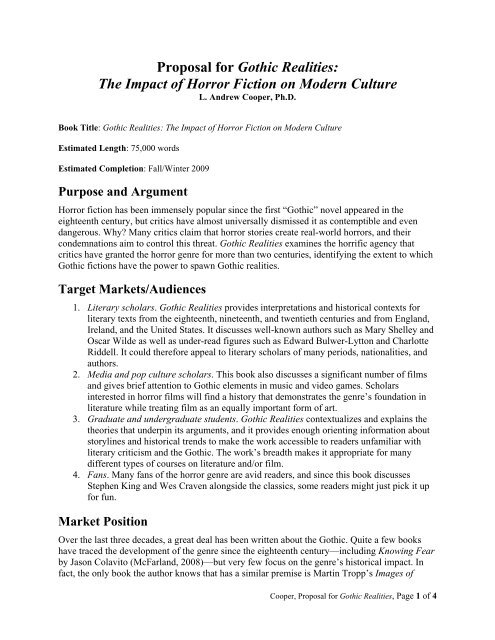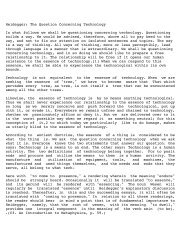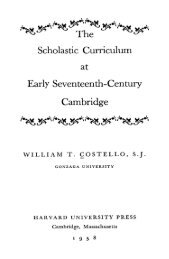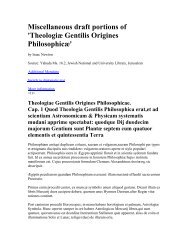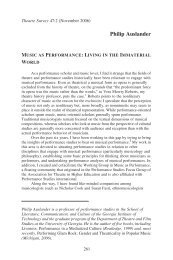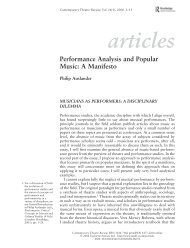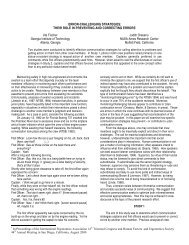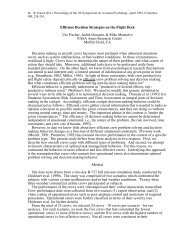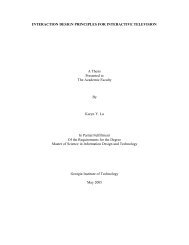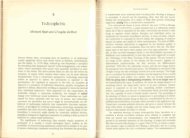Proposal for Gothic Realities - The School of Literature ...
Proposal for Gothic Realities - The School of Literature ...
Proposal for Gothic Realities - The School of Literature ...
Create successful ePaper yourself
Turn your PDF publications into a flip-book with our unique Google optimized e-Paper software.
<strong>Proposal</strong> <strong>for</strong> <strong>Gothic</strong> <strong>Realities</strong>:<br />
<strong>The</strong> Impact <strong>of</strong> Horror Fiction on Modern Culture<br />
L. Andrew Cooper, Ph.D.<br />
Book Title: <strong>Gothic</strong> <strong>Realities</strong>: <strong>The</strong> Impact <strong>of</strong> Horror Fiction on Modern Culture<br />
Estimated Length: 75,000 words<br />
Estimated Completion: Fall/Winter 2009<br />
Purpose and Argument<br />
Horror fiction has been immensely popular since the first “<strong>Gothic</strong>” novel appeared in the<br />
eighteenth century, but critics have almost universally dismissed it as contemptible and even<br />
dangerous. Why? Many critics claim that horror stories create real-world horrors, and their<br />
condemnations aim to control this threat. <strong>Gothic</strong> <strong>Realities</strong> examines the horrific agency that<br />
critics have granted the horror genre <strong>for</strong> more than two centuries, identifying the extent to which<br />
<strong>Gothic</strong> fictions have the power to spawn <strong>Gothic</strong> realities.<br />
Target Markets/Audiences<br />
1. Literary scholars. <strong>Gothic</strong> <strong>Realities</strong> provides interpretations and historical contexts <strong>for</strong><br />
literary texts from the eighteenth, nineteenth, and twentieth centuries and from England,<br />
Ireland, and the United States. It discusses well-known authors such as Mary Shelley and<br />
Oscar Wilde as well as under-read figures such as Edward Bulwer-Lytton and Charlotte<br />
Riddell. It could there<strong>for</strong>e appeal to literary scholars <strong>of</strong> many periods, nationalities, and<br />
authors.<br />
2. Media and pop culture scholars. This book also discusses a significant number <strong>of</strong> films<br />
and gives brief attention to <strong>Gothic</strong> elements in music and video games. Scholars<br />
interested in horror films will find a history that demonstrates the genre’s foundation in<br />
literature while treating film as an equally important <strong>for</strong>m <strong>of</strong> art.<br />
3. Graduate and undergraduate students. <strong>Gothic</strong> <strong>Realities</strong> contextualizes and explains the<br />
theories that underpin its arguments, and it provides enough orienting in<strong>for</strong>mation about<br />
storylines and historical trends to make the work accessible to readers unfamiliar with<br />
literary criticism and the <strong>Gothic</strong>. <strong>The</strong> work’s breadth makes it appropriate <strong>for</strong> many<br />
different types <strong>of</strong> courses on literature and/or film.<br />
4. Fans. Many fans <strong>of</strong> the horror genre are avid readers, and since this book discusses<br />
Stephen King and Wes Craven alongside the classics, some readers might just pick it up<br />
<strong>for</strong> fun.<br />
Market Position<br />
Over the last three decades, a great deal has been written about the <strong>Gothic</strong>. Quite a few books<br />
have traced the development <strong>of</strong> the genre since the eighteenth century—including Knowing Fear<br />
by Jason Colavito (McFarland, 2008)—but very few focus on the genre’s historical impact. In<br />
fact, the only book the author knows that has a similar premise is Martin Tropp’s Images <strong>of</strong><br />
Cooper, <strong>Proposal</strong> <strong>for</strong> <strong>Gothic</strong> <strong>Realities</strong>, Page 1 <strong>of</strong> 4
Fear: How Horror Stories Helped Shape Modern Culture (McFarland, 1990). <strong>The</strong> proposed<br />
book’s subtitle, <strong>The</strong> Impact <strong>of</strong> Horror Fiction on Modern Culture, acknowledges Tropp’s strong<br />
influence on the dissertation that inspired it, but <strong>Gothic</strong> <strong>Realities</strong> ultimately covers a broader<br />
historical range and explores horror fiction not as something readers use to make sense <strong>of</strong> their<br />
worlds but as something that might actually have helped to create them. In doing so, it addresses<br />
a number <strong>of</strong> issues that have been central in <strong>Gothic</strong> criticism (especially <strong>Gothic</strong> sexuality, a topic<br />
at the centers <strong>of</strong> early works by Eve Sedgwick and Judith Halberstam) while also paying<br />
attention to significant but neglected issues such as the relationship between fictional and “true”<br />
ghost stories. <strong>Gothic</strong> <strong>Realities</strong> there<strong>for</strong>e marks a different direction <strong>for</strong> an established field,<br />
contributing to ongoing conversations while breaking ground <strong>for</strong> further research.<br />
Annotated Table <strong>of</strong> Contents<br />
Introduction: Bad Influences and <strong>Gothic</strong> <strong>Realities</strong><br />
For centuries, outraged pundits and parents have accused scary stories <strong>of</strong> making the world a<br />
scary place. Citing examples <strong>of</strong> crimes patterned on fictional models, these people argue that<br />
horror fictions cause real-world horrors. <strong>The</strong> introduction grants that strong relationships do exist<br />
between horror fiction and reality—this book is all about those relationships—but it provides a<br />
theoretical foundation <strong>for</strong> understanding why fiction can’t be responsible <strong>for</strong> real-world events.<br />
Part One: <strong>Gothic</strong> Threats<br />
1. <strong>The</strong> Threat in the <strong>Gothic</strong>’s Foundation: From John Locke to Horace Walpole<br />
Self-proclaimed “<strong>Gothic</strong>” fiction began in 1764 with the publication <strong>of</strong> Horace Walpole’s <strong>The</strong><br />
Castle <strong>of</strong> Otranto, which pleased critics when they thought it was manuscript recovered from<br />
medieval times but horrified them when they learned that it was a contemporary production.<br />
This chapter argues that critics’ outrage over Walpole’s literary experiment stemmed from<br />
their internalization <strong>of</strong> philosophical principles from the works <strong>of</strong> John Locke and David<br />
Hume, principles that frame human minds and behaviors as products <strong>of</strong> environmental<br />
influences. Eighteenth-century critics expected contemporary literary works, environmental<br />
influences par excellence, to model good behavior. <strong>The</strong> tradition that Walpole started did the<br />
opposite, marking the <strong>Gothic</strong> as inherently antagonistic to virtue and social stability.<br />
2. <strong>The</strong> Role <strong>of</strong> <strong>Gothic</strong> Threats in the Critical Evaluation <strong>of</strong> <strong>The</strong> Monk and <strong>The</strong> Mysteries <strong>of</strong><br />
Udolpho<br />
This chapter examines how the critical reception <strong>of</strong> two <strong>of</strong> the eighteenth century’s most<br />
famous <strong>Gothic</strong> novels exemplifies critics’ understanding <strong>of</strong> <strong>Gothic</strong> threats: Matthew Lewis’s<br />
<strong>The</strong> Monk seemed to do everything possible to corrupt readers, and Ann Radcliffe’s <strong>The</strong><br />
Mysteries <strong>of</strong> Udolpho seemed to counteract its genre’s tendencies and thus foster a virtuous<br />
readership. Critics there<strong>for</strong>e excoriated Lewis and beatified Radcliffe. <strong>The</strong> terms <strong>of</strong> critics’<br />
pronouncements provide a sort <strong>of</strong> checklist <strong>for</strong> the threats the <strong>Gothic</strong> poses: the <strong>Gothic</strong><br />
threatens to warp the young, subvert gender norms, inspire heretical beliefs in the<br />
supernatural, and undermine the established social order. <strong>The</strong> rest <strong>of</strong> <strong>Gothic</strong> <strong>Realities</strong> explores<br />
how the <strong>Gothic</strong> has indeed been involved in each <strong>of</strong> these pernicious activities.<br />
Cooper, <strong>Proposal</strong> <strong>for</strong> <strong>Gothic</strong> <strong>Realities</strong>, Page 2 <strong>of</strong> 4
Part Two: <strong>Gothic</strong> Sexualities<br />
3. Pathological Reproduction: <strong>The</strong> Emergence <strong>of</strong> Homosexuality through 19 th -Century<br />
<strong>Gothic</strong> Fiction<br />
Literary historians have demonstrated that the prosecution <strong>of</strong> Oscar Wilde in 1895 <strong>for</strong> samesex<br />
sexual <strong>of</strong>fenses played a pivotal part in the emergence <strong>of</strong> the category “homosexual” as<br />
we understand it today. Considering the role <strong>of</strong> Wilde’s <strong>Gothic</strong> novel <strong>The</strong> Picture <strong>of</strong> Dorian<br />
Gray during Wilde’s trials, this chapter explores how the <strong>Gothic</strong> trope <strong>of</strong> pathological<br />
reproduction, which depicts <strong>of</strong>ten unspecified illicit sexuality as a monstrous contagion,<br />
contributed to the belief that homosexuality is a disease that gays and lesbians spread through<br />
monstrous recruiting practices. Tracing pathological reproduction through Frankenstein,<br />
Melmoth the Wanderer, Carmilla, and <strong>The</strong> Strange Case <strong>of</strong> Dr. Jekyll and Mr. Hyde, this<br />
chapter demonstrates not that the <strong>Gothic</strong> is in some ways homosexual (a common claim) but<br />
that the homosexual is in a crucial way <strong>Gothic</strong>.<br />
4. Romps in the Closet: <strong>The</strong> Persistence <strong>of</strong> 19 th -Century Notions in Contemporary Pop<br />
Culture<br />
Though the association between non-normative sexuality and <strong>Gothic</strong> monstrosity is perhaps<br />
easiest to see in the anti-gay rhetoric spewed by groups such as the Traditional Values<br />
Coalition, the association is actually ubiquitous, even in texts understood to be gay-friendly.<br />
For example, the television show Buffy the Vampire Slayer, praised by some <strong>for</strong> progressively<br />
including a lesbian as a major character, nevertheless links homosexuals to evil werewolves<br />
and witches. Perhaps more interestingly, the horror films <strong>of</strong> David DeCoteau, embraced by<br />
queer communities <strong>for</strong> their homoeroticism, continue the 19 th -century tradition <strong>of</strong> depicting<br />
characters as heterosexuals tainted by monstrosities that just happen to involve them in<br />
homoerotic circumstances. <strong>The</strong>se films don’t just repeat the <strong>for</strong>mula homosexual = monster—<br />
they revel in it, turning a once-shameful association into a site <strong>of</strong> pleasure.<br />
Part Three: <strong>Gothic</strong> Ghosts<br />
5. Ghost Stories and Ghostly Belief: Conventional Horrors that Make Good Truths<br />
To earn their readers’ beliefs, “true” ghost stories have to include elements that readers<br />
recognize as ghostly, and what readers are most likely to recognize are the elements they’ve<br />
seen in ghost fictions. This chapter shows how the language <strong>of</strong> ghost fictions in<strong>for</strong>ms reports<br />
and perceptions <strong>of</strong> ghosts by Spiritualists, ghost hunters, and parapsychologists. By providing<br />
a language to describe supernatural experiences, the fictions <strong>of</strong> Daniel Defoe, Charles<br />
Dickens, Elizabeth Gaskell, Algernon Blackwood, Shirley Jackson, and many less wellknown<br />
writers help to define the “real” ghost. <strong>The</strong> resulting similarities between fact and<br />
fiction help to convert skeptics into believers, and their conversions threaten not only to create<br />
more believers in ghosts but also, according to some, more ghosts.<br />
6. Ghost Epistemology: Five or Six Ways to Haunt the Senses<br />
In cultures where authoritative claims about reality require the support <strong>of</strong> empirical data, a<br />
thing’s status as reality <strong>of</strong>ten depends on whether that thing appears to the senses. By giving<br />
readers language to describe supernatural experiences, ghost fictions also create an<br />
epistemological framework within which people can legitimately hear, see, touch, and smell<br />
ghosts. <strong>The</strong>y even help to define the phenomenon named by M. Night Shyamalan’s film <strong>The</strong><br />
Cooper, <strong>Proposal</strong> <strong>for</strong> <strong>Gothic</strong> <strong>Realities</strong>, Page 3 <strong>of</strong> 4
Sixth Sense, a capacity that stretches the boundaries <strong>of</strong> empiricism. This chapter examines<br />
dozens <strong>of</strong> stories in print and film that provide the parameters <strong>for</strong> sensing real ghosts.<br />
Part Four: <strong>Gothic</strong> Violence<br />
7. Fictions that Kill: Columbine, Virginia Tech, and Stephen King’s Only Out-<strong>of</strong>-Print<br />
Novel<br />
Recent studies have debunked the notion that the teenagers who killed 13 people at<br />
Columbine High <strong>School</strong> on April 20, 1999 were relatively normal but mistreated “Goth” kids<br />
who responded to bullying with murder. Nevertheless, the horrors at Columbine, Virginia<br />
Tech, and other schools have so much in common with <strong>Gothic</strong> elements in music, video<br />
games, literature, and film that contemporary critics and pundits continue to decry the dangers<br />
the <strong>Gothic</strong> poses to young people and to social order. This chapter takes a closer look at the<br />
claims about a causal link between horrific stories and horrific realities that arise again and<br />
again in debates about media violence. <strong>The</strong> chapter critiques the media-blaming rhetoric that,<br />
despite its flaws, managed to convince Stephen King that he should take his novel Rage—<br />
about a teenager who brings a gun to school—out <strong>of</strong> circulation because it seems to have<br />
spawned real-world copycats.<br />
8. Violent Self-Reflection: Natural Born Killers, Wes Craven’s Nightmares, and Torture<br />
Porn<br />
Like Rage, the films Natural Born Killers and Scream have been accused <strong>of</strong> inspiring real-life<br />
crimes. <strong>The</strong>se films, as well as many <strong>of</strong> the others most frequently blamed <strong>for</strong> causing realworld<br />
horror, share a kind <strong>of</strong> self-consciousness that sets them apart from other horror films.<br />
Indeed, Natural Born Killers and Scream are in many ways about the relationship between<br />
media violence and real-world violence. <strong>The</strong>se films, as well as the condemnations they’ve<br />
inspired, ultimately demonstrate that what people fear is not the films’ causal potential but the<br />
knowledge the films impart. <strong>The</strong> <strong>Gothic</strong>’s detractors assume that ignorance <strong>of</strong> violence could<br />
save the world from violence, and the films they hate most are the ones that critique the<br />
valorization <strong>of</strong> ignorance. A recent trend in horror films, dubbed “torture porn” by David<br />
Edelstein, is perhaps most threatening not because the films are gory but because their fixation<br />
on torture critiques the façade <strong>of</strong> ignorance that Americans strive to maintain about their own<br />
violent <strong>for</strong>eign policy.<br />
About the Author<br />
L. Andrew Cooper holds a Ph.D. from Princeton University, where he did research on horror<br />
fiction and film. He is now finishing his fourth year teaching in Georgia Tech's <strong>School</strong> <strong>of</strong><br />
<strong>Literature</strong>, Communication, and Culture, where he serves as Coordinator <strong>of</strong> the Writing and<br />
Communication Program. At Georgia Tech he has taught several classes focusing on horror<br />
fiction and film and has published a number <strong>of</strong> articles, including a version <strong>of</strong> the second chapter<br />
<strong>of</strong> this book, which appeared in <strong>Gothic</strong> Studies in 2006.<br />
Cooper, <strong>Proposal</strong> <strong>for</strong> <strong>Gothic</strong> <strong>Realities</strong>, Page 4 <strong>of</strong> 4


